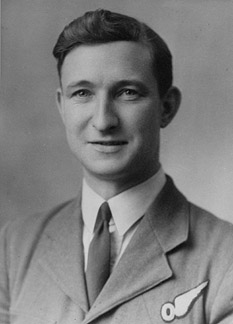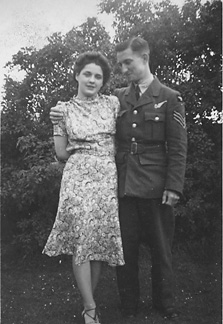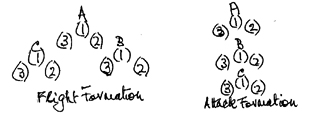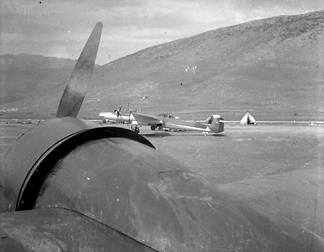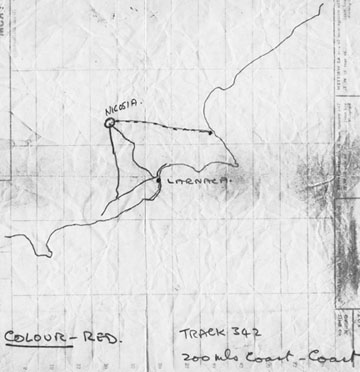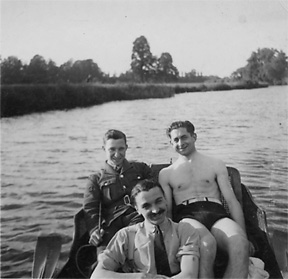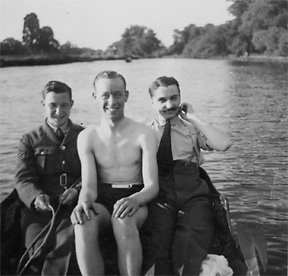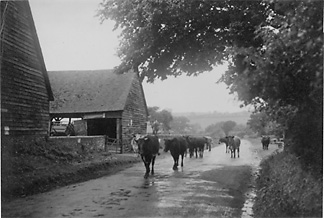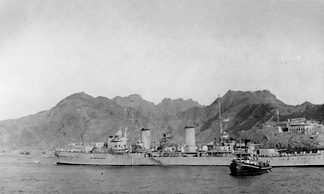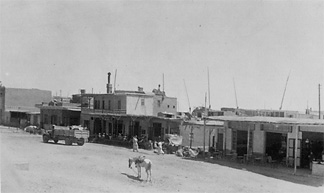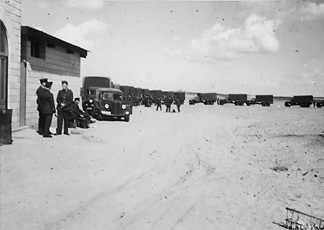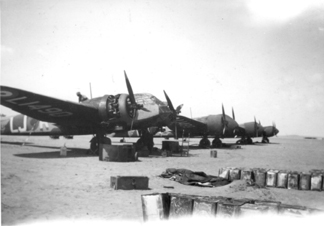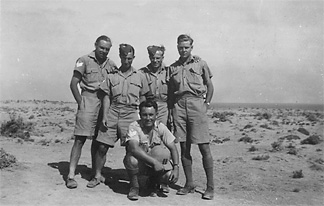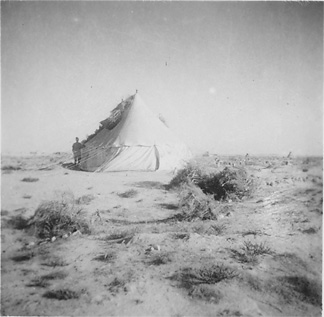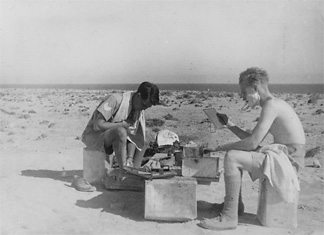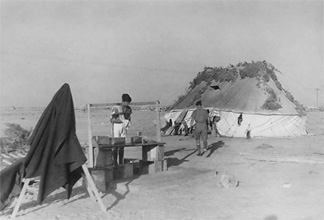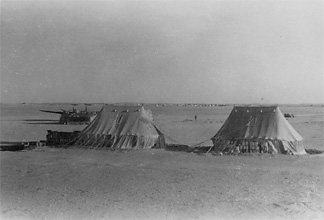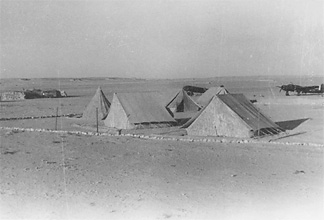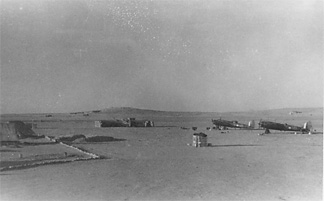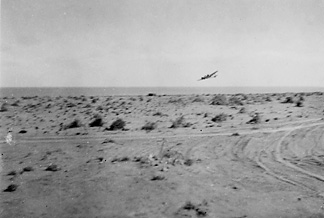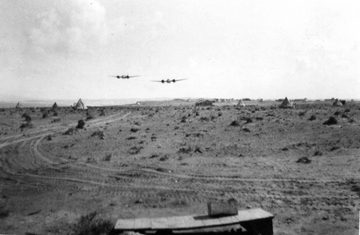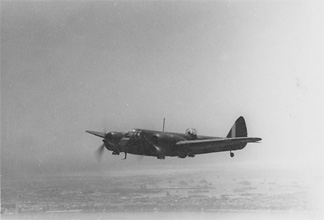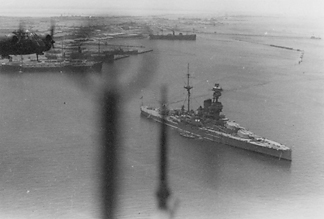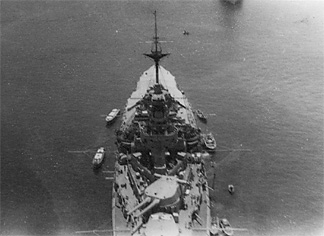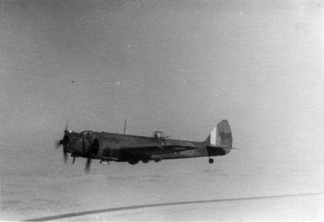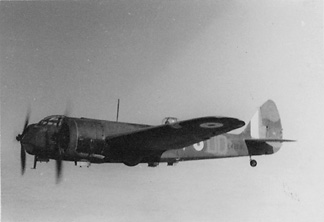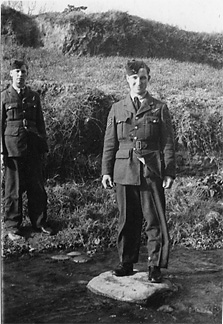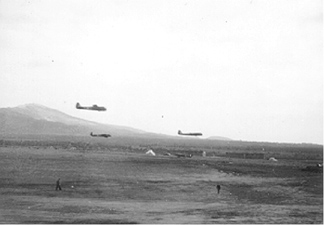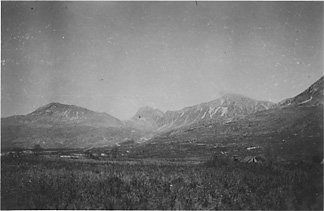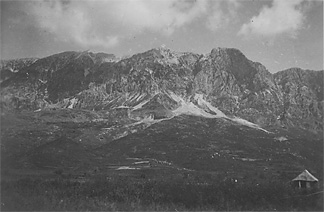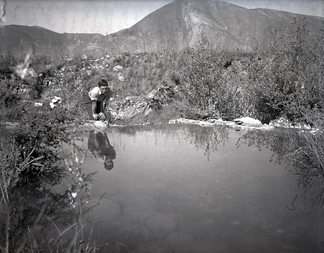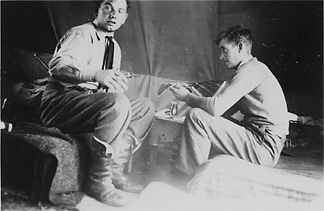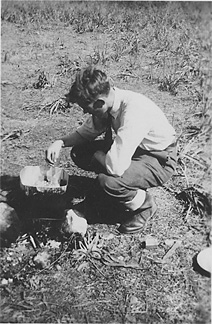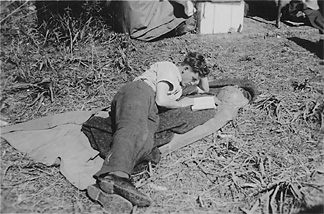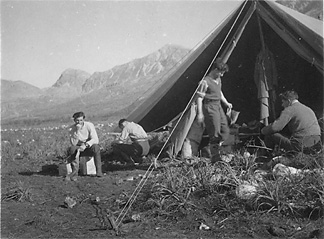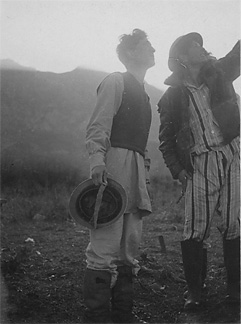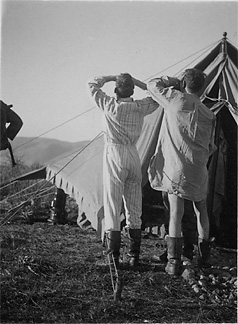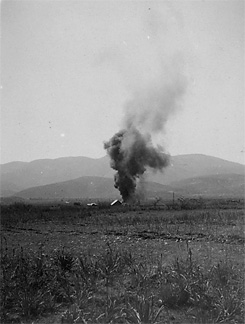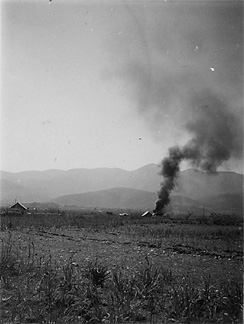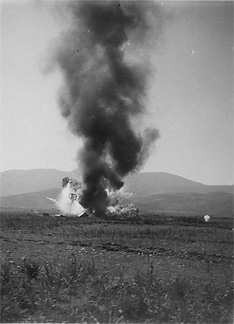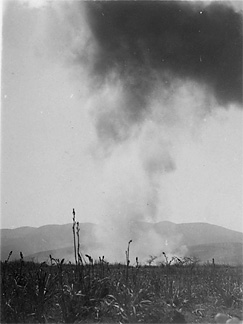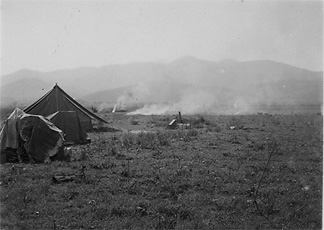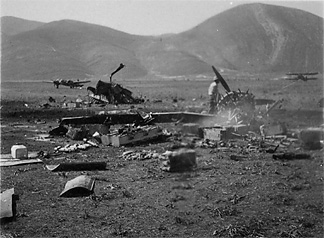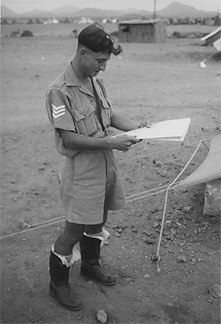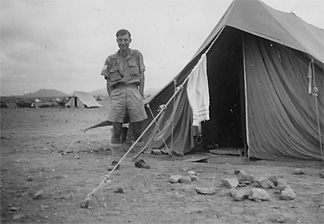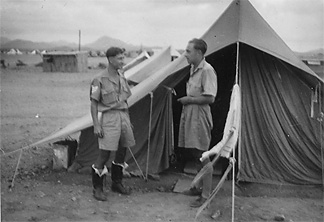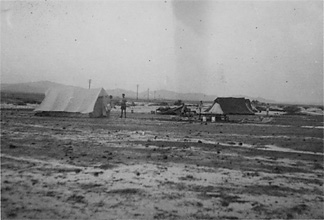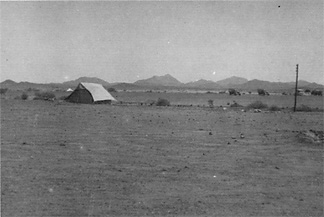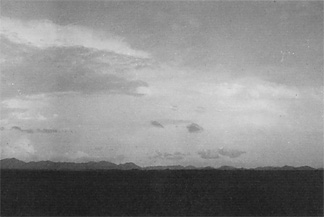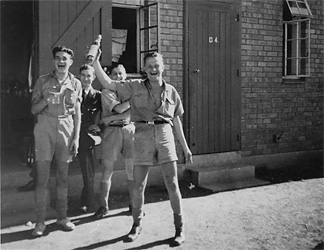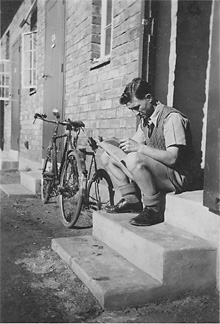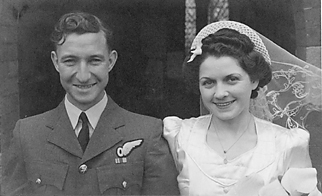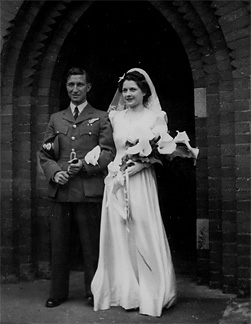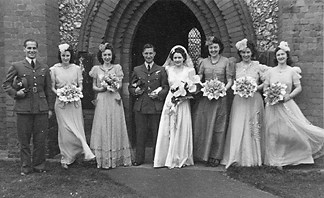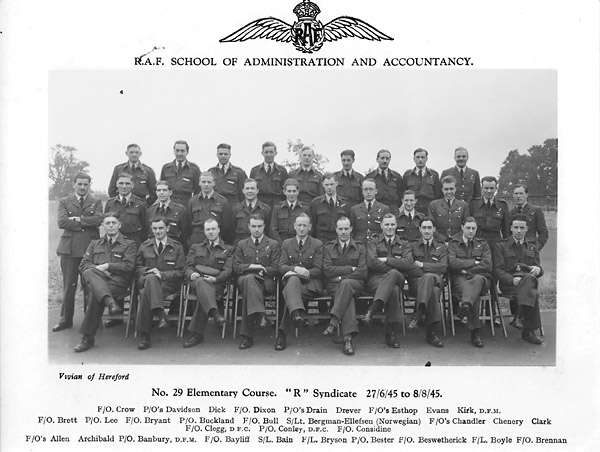 |
 |
||||||||||||||||||||||||||||||||||||||||||||||||||||||||||||||||||||||||||||||||||||||||||||||||||||||||||||||||||||||||||||||||||||||||||||||||||||||||||||||||||||||||||||||||||||||||||||||||||||||
|
CFR Clark Sergeant 745462 Flight Lieutenant 173855 RAFVR The account which follows is the foundation of my 211 Squadron research, arising from notes my father wrote for me in 1996. One of the larger narratives on site, the story is divided into these sections: THE STORY UNFOLDS
Alight with optimism though at the very gates of war. Newly qualified as Observer and about to be posted overseas, he and my mother had just become engaged. On 3 September 1939 he was called up for full-time service and posted to Cambridge TC, set up in Jesus College and shortly re-established there as 1 ITW. From there he passed on to 6 AONS Staverton in November 1939. He completed an Observers air navigation course there at the end of March 1940, followed by bombing and gunnery training at 4 BGS West Freugh, which he completed in mid-May. By then the Battle of France had begun. From 18 May he was posted to 12 OTU Benson in Oxfordshire, to complete his training on Fairey Battles. Boating with RAF friends on the River Thames late one off-duty afternoon at the end of May, as they neared Wallingford Bridge he struck up a conversation with a young woman taking a photograph, Betty Hawkins. They met again. It was a match. They went out together as often as they could, when they couldn’t, they wrote letters. Many, many letters, almost daily.
On Wallingford Bridge, where they first met. “It won’t come out you know!” What would he know, she shot back, quick as a flash. They would spend the next 60-odd years finding out. In France that Spring, the RAF’s Battle and Blenheim Squadrons flew daylight bombing raids against terrible odds and paid a very heavy price. On 11 July 1940 my father completed his Operations course at Benson. Soon his best blue was resplendent with Sergeant’s stripes and the winged “O” badge of the Observer. Posted to Uxbridge on 14 July, he was sent on 48 hours embarkation leave almost at once, so he promptly sought out Betty and took her home for the weekend to meet his mother and sister Joan in Cambridge. By the following Saturday they were engaged. She was just 19. He was 24.
Sgt CFR “Nobby” Clark & Miss Betty Ruth Hawkins 1940. The original title is a reference to the newly acquired Observer’s badge. This is very probably their engagement photograph in July 1940. Aircrew cherished their originally issued insignia, fought successfully to retain them as RAF musterings and badges changed, and (for Observers, at least) awarded their own robust Anglo-Saxon nickname to their winged ‘O’ badge. On Wednesday 24 July 1940, he boarded the troopship SS Reina del Pacifico at Liverpool bound for the Middle East, sailing on the morning tide next day. Having voyaged via Freetown, Cape Town, Durban and Aden, his draft disembarked at Port Said in September. Posted to No. 211 (Bomber) Squadron RAF on 5 September 1940, within days he joined the Squadron in the Egyptian Western Desert, moving to Greece with them later that year, and then on to Palestine in May 1941. In the eight months from the end of September 1940 to the end of May 1941, he took part in some 55 operational flights (of which 42 were raids, offensive reconnaissance or escort duty), for a completed tour amounting to some 130-odd hours flying, all most all in Blenheim Is. During those months, the Squadron suffered the loss of 33 of its own aircrew (three of whom survived as PoWs) and of two other Air Force colleagues. The Squadron was stood down from operations in June 1941, for aircrew training duties while forming 72 OTU at Wadi Gazouza in The Sudan. In January 1942, as the Squadron was re-forming at Helwan in Egypt for the Far East operational posting, he left them, tour expired. Promoted Warrant Officer in February as a navigation instructor, he was posted to 47 Air School Queenstown and later, 48 Air School Port Elizabeth. Repatriated to the UK in March 1945 aboard HMT Andes with just under 500 hours in his Log Book, he marched out a Flight Lieutenant from 100 PDC in November 1945, his last day of RAF service coming on 22 February 1946. It was 1959 before he finally relinquished his commission. Squadron practices, 1940 The two flight formation diagrams in Aircrew in Greece, below, thus show the formations adopted for a full Squadron operation. With limited defensive firepower, the aim was to operate in formations which allowed the turret gunners to concentrate their fire in the event of interception. If attacked, the object was to maintain formation and if at all possible to seek cloud cover. Attempting to break contact by diving to the ground was likely to invite disaster. An aircraft might be classed as unserviceable for any of a number of reasons from the readily repairable on-site, such as a punctured tyre, to the more serious breakages of tail-wheels and stern-frames (not uncommon on unsurfaced airfields) or battle damage. In addition, aircraft might be undergoing scheduled maintenance. Unserviceable thus implied unfit for immediate operational use, rather than unflyable. So for instance, in providing HM Peter, King of the Yugoslavs with an escort from Paramythia to Athens (a matter of protocol apart from anything else), the Squadron’s CO provided an unserviceable Blenheim: flyable, but with no turret (see Operations in Greece, April 14). This action carried much meaning, one way and another. There was clearly confidence that the “boys” could manage, even effectively unarmed. Equally clearly, the response to the Royal presence was both practical and pragmatic. Too bad about the sheet of plywood...perhaps Peter wasn't told. And for once Bill got to sit down in the warm. THE NOTES of CFR CLARK In the five sections below, my father’s narrative is taken verbatim from his foolscap manuscript narrative and its transcript, the March 1998 edition of 211 Squadron RAF, Greece 1940—1941, also taking in the later printed Errata and Addendum. In transferring text from Acrobat PDF to HTML, I have remained faithful to my father’s original ms layout as far as the software will allow. While I have omitted most of his lavish use of capitals (eg in person and place names) and the long dash (both of which stem from RAF usage), the text is my father’s own inimitable style. In reviewing my compilation of his notes, my father made corrections and further comments to his original manuscript, marked thus *. For the few remaining inconsistencies and for certain amplifications, my own notes, which have been added to over time, appear in the usual [square brackets]. AIRCREW IN GREECE My father’s lists show aircrew personnel as complete crews by Flight. The rolls include those who replaced others killed or missing in action. Later transfers between Flights, replacements and postings are shown by my father’s footnotes. A short list of other Squadron personnel follows the ‘A’ Flight roll. After the ‘B’ and ‘C’ Flight rolls come my father’s Note on personnel, operations and his Flight diagrams. The last roll, by date, is his list of Squadron personnel killed or missing in action during his time with them.] Wings Over Olympus: 211 Squadron crew lists ‘A’ Flight F/Lt Farrington (Dinkum)—Flight Commander [Later S/Ldr 582 Squadron KIA 29 August 1944] F/O Dundas DFC (Ken) P/O Herbert (Herby) P/O Cox (Pip) Sgt Marshall DFM (Jock) P/O Hooper3 * This is an error. P/O Bevington-Smith (Smithy) was Observer in the crew of P/O Cox (Pip); but after 22 Jan [1941] Sgt Martin (Jerry) replaced him [see Operations in Greece] ‘B’ Flight F/O Clutterbuck F/O Delaney (Duke) P/O Hooper3 F/O Buchanan [DFC] (Buck) Flight commander after posting of F/Lt Doudney F/O Austin (Jock) F/O Campbell (Bobby) Sgt Baker (Frank) Sgt Davis (Doug)* ‘C’ Flight P/O Thompson DFC (Tommy) P/O Pearson DFC (Twink) [“Twinkle”] P/O Godfrey (Alan) Sgt James (Jimmy) P/O Pickersgill (Pickers)** P/O Jerdein (The Airedale)** Sgt Bennett * This crew was in ‘C’ not ‘B’ Flight. [Sgt Trenholm, according to the 211 Squadron Operations Record Book, Form 540 and Form 541 (UK National Archives AIR 27/1302). The spelling of crew names was not always accurate. This turns out to be a curious lacuna. On checking my father’s copy of Wings Over Olympus recently, he had correctly cited Trenholm’s name in his earliest list. It seems likely that he endeavoured to ”correct” himself from memory in making his transcription.] Ground Crew Note S/Ldr Nedwill a few days after joining ploughed a Gladiator into the airfield from about 6,000 ft. The last Squadron raid (against Kosani airdrome) in Greece was a single aircraft on night of 19/20 April (the only serviceable aircraft remaining); Sgt Marshall, Sgt Clark, Sgt Baird. The Luftwaffe followed us in to Menidi at 6:30 am just after we had landed; result in loss of all aircraft on ground including a Vickers Virginia transport [sic: a Valentia, see comments 20 April]; AND in the evacuation of all Squadron aircrew to Corfu [sic: Crete, see Operations in Greece comments 21 April] (and on to Alexandria) next day (21/4).
Aircrew lost in Greece and Syria
OPERATIONS IN GREECE For most of the period in Greece, his crewmates were the late Sgt John Roy (Jock) Marshall DFM (Pilot) and the late Sgt William (Bill) Baird (Wireless operator/Air Gunner). He refers to the crew variously as Sgt Marshall and Co, Sgt Marshall et al or simply Sgt Marshall (and later, Sgt Marshall DFM).] Fighters over the Desert page 19 Air War For Yugoslavia, Greece and Crete 1940—41 Perhaps Smithy (Bevington-Smith) had a memory lapse [ie in his mis-spelling of Farrington’s surname]. Seem to recollect he [Smithy] did not return to the Squadron after his accident on the raid of 22/1/41. After that time the crew was P/O Cox, Sgt Martin (Jerry), Sgt Hughes. [Cox, Bevington-Smith and Hughes had to force-land at Araxos on 22 January with the starboard engine afire. Flying on the port engine only, they arrived in the nick of time only to sink nose-down into the partly prepared runway. Smithy ended up in the nose, breaking his teeth on the bombsight. Eric and Pip Cox didn't get back to Paramythia until 15 February after this incident, and Dad apparently mis-remembered the detail of E B-S’ absence. Alison Legge has added that she and Allan Farrington were married in Athens that March, their marriage lines signed by S/Ldr Irvine.] page 65 ‘A’ FLIGHT [The Western Desert air campaign is discussed in great detail in Air Historical Branch RAF—Narrative—Middle East Campaigns—Vol I—Operations in Libya and The Western Desert September 1939 to June 1941. Pages 9-64 indicate the intensity of activity undertaken from May to September 1940. After the loss of a Blenheim shooting-up ground targets on 5 July, ACM Longmore signalled A/Cdr Collishaw “...such operations unjustified, having regard to our limited resources of which you are well aware” (also noted in RAF 1939-1945 Vol I). Pages 66-70 discuss the Greek campaign and scarcity of resources to support it. See also Marshall’s Log Book for this period.] 7/11/40 L1481 Sgt Marshall, Sgt Clark, Sgt Baird page 41 [The speed of this move and the subsequent, almost immediate offensive mission from Tatoi (Menidi) has been remarked upon in various sources. Despite pressure from General Papagos and others for close support of the Greek Army in Albania, AVM D’Albiac determined upon attacking strategic, rear targets; partly in order to conserve the slender force at his disposal. See D’Albiac, Report on Air Operations in Greece, opening paras. This policy continued until February, when the Western Wing was formed and 211 Squadron moved to Paramythia. Some more modern commentators have sought to criticise D'Albiac for rigidly adhering to Air Force doctrine. It is worth bearing in mind that before departing to Greece, there was an irate exchange of command level signals about the poor availability spares, lest the Bomber squadrons be provided with a single spare aircraft fuel tank per squadron! Likewise, in 211 Squadron, a stores officer who wangled spare engines beyond entitlement before departure was posted for his pains. Hardly inducements to low-level operations. Bombing-up is further discussed and illustrated in Blenheim armament and JE Fryatt] page 42 Sgt Marshall & co pursued; by evasive action & finally at ground level “Jock” got us out of it—with “Haggis” letting fly with the VGO & “Nobby” letting off Very lights; made Larissa, badly shot up, with the port engine in serious trouble—leave L1481 at Larissa, return to Menidi in a Greek Ju52 on 25/11. page 49 page 50 page 51-52 [See D’Albiac para 14. Despite the urgings of Greek commanders for close air support during this period, the Greek Government remained determined not to provoke the Germans, limiting RAF bases to those in the Athens area. In any event, the winter state of potential forward airfields and access to them was very poor.] 9/12 L1481 Sgt Marshall ‘C’ FLIGHT page 59 page 62 [The Commonwealth War Graves Commission commemorates these men on the Alamein Memorial—usually an indication that they are missing in action. However, according to a late 1950s International Record Cross report, the three Sergeants of L1540 lie in the Albanian village of Mavrove with its little church, some 10 miles (15km) from Valona (now Vlores) just east of the main road to the mountainous south. The village is more or less on the direct course from Valona to Paramythia.] page 64 page 65-66 page 67 or 68 19/1 L8533 Sgt James page 70 ‘A’ FLIGHT [ie Sgt Clark thereby returns to ‘A’ Flight, but to P/O Hooper's crew initially. P/O JCR and P/O JGM Hooper, the Rhodesian brothers, joined the Squadron on 23 January as pilots. Both survived the war.] page 75 page 78 move to Paramythia was on 10/2 not 9/2 10/2 L1481 Sgt Marshall] Menidi—Paramythia [RAF 1938-1945 Vol 1 p285 notes “a dry patch of ground for a few Blenheims had been found near the front”. D’Albiac (para 30) considered the Western Wing as comprising one Bomber Squadron (211 at Paramythia) and one Fighter Squadron (80 at Yannina, with the Air HQ). At Paramythia, detachments eg from 30 Squadron (Blenheim Is), 84 Squadron (Blenheim 1s), 80 Squadron (Gladiators, then Hurricanes) or 112 Squadron (Gladiators) arrived and departed as need dictated.] page 82 13/2 L6634 Sgt Marshall] Paramythia—Menidi—Paramythia page 84 page 85 page 86 [D’Albiac para 21 notes 4 Hurricane victories on this day] page 88 page 89 page 91 26/2 L8531 Sgt Marshall page 92 page 97 1/3 L8513 Sgt Marshall 2/3 L8513 Sgt Marshall page 99-100 page 103 8/3 L1496 Sgt Marshall page 105 page 105 page 114 page 114-116 “as the book” page 116 19/3 L8478 Sgt Marshall DFM 20/3 L8513 Sgt Marshall DFM page 118 page 120-123 [The continuing difficulty of transport by road or sea to Paramythia meant the Squadron freighting their own bombs.] page 123 page 123 page 125 page 242 L8478 S/Ldr Irvine†, P/O Davis† [sic: Davies], P/O Geary† and the “lucky” ones—Sgt Dunnet (W/Cdr Coote) and Sgt Kavanagh (S/Ldr Cryer DFC) [* Missing: listed on Alamein Memorial In the knowledge that no fighter cover was available, Coote (OC Western Wing BAFG) and his deputy Cryer had stepped forward to “have a look”. Coote, a very experienced officer, had sat in on earlier raids. For example, on 23 February he went on a 211 Squadron raid on Duki (near Tepelene) as Observer to P/O JC “Pip” Cox, and again on 27 February to Valona (modern Vlores) with P/O JCR Hooper. During the course of the day, the Squadron had already mounted two raids without loss. The seventh serviceable Blenheim had been on one of those, piloted by Jock Marshall with Bill Baird as WOp/AG. This operation is not recorded in my father’s Log Book—presumably some-one else went as Observer. Later that morning, Marshall was tasked to collect another aircraft and return to Paramythia. Delayed in his return, he and the aircraft were scrubbed from the later operation. The crew would, apparently, have been Marshall, Clark and Baird. Thanks to the 1979 and later efforts of Messrs Bryce (brother of F/Sgt Andy Bryce) and Marshall, Quill, Dunnet and Nourse, details of the crash sites of the aircraft are now recorded. Previously unidentified aircrew recovered by the MRES post-war for burial in Phaleron War Cemetery are now identified, and commemorated there as far as they can be known. Those who today rest in Phaleron are noted thus † in the list above. All are commemorated on the Commonwealth War Graves Commission site, whether at Phaleron or on the Alamein memorial in Egypt. It was not possible, in the post-war Balkans, to recover all the lost aircrew. Having survived the immediate action, Godfrey and James helped bury those of their friends they could find, then somehow, with the help of the Greeks, struggled back to Larissa. On the following Tuesday, the two were to be evacuated from the little town of Kazaklar some 10 miles to the North (modern Ampelonas), where 208 Squadron was based. Shortly after take-off that morning, the two Westland Lysanders in which they were passengers were attacked and shot down by Me 109s. In the rear of F/O DB Waymark’s Lysander L4719, Godfrey was able to return fire with the free-mounted VGO, despite losing two fingers to the attacker’s shooting before the aircraft crashed. Wounded in the legs, he was extricated by his uninjured pilot, both having to take cover from the ensuing ground-strafe. By chance, back in the desert days, this aircraft had been photographed by Geoff Grierson. P/O JW Stewart’s Lysander L4690 also came under attack and was also shot down. Stewart survived, slightly injured, but Jimmy James did not. He remains missing to this day. Finally evacuated to Athens and hospital, Godfrey recovered and was later awarded the DFC and the Greek DFC. He survived the war and, still serving in the RAF, was seconded to BOAC from May 1945 to fly with their BEA arm in 1946. On 7 August 1946, he was flying as First Pilot to Captain LK Fennell DFC in BEA Douglas C-47A G-AHCS, with a crew of five and ten passengers. In poor weather, the aircraft flew into Mistberget mountain on approach to Oslo. Three of the cockpit crew of four were killed instantly: among them, S/Ldr Alan Clement Godfrey DFC. The fourth member later died of injuries received. The cabin steward and seven of the ten passengers were injured. S/Ldr Irvine was subsequently mentioned in despatches, 24 September 1941. Sgt Observer James Dunnet recorded the story of Easter Sunday in rich and poignant detail in his Blenheim Over The Balkans and, over the preceding twenty years, in several earlier forms (see Sources).] page 247 [& page 148] [See Cpl Dudman for photographs of this occasion. While Short Sunderland in World War II p38,39 speculates that F/Lt Lywood (N9029) had evacuated the young Yugoslav King from Kotor on 16 April, that is clearly wrong. The error arises from a garbled entry in the BAFG HQ ORB, repeated in Longmore's second Middle East despatch and later in various other accounts. Lywood's Kotor sortie was to collect diplomatic staff. Alison Legge recalled that her husband F/Lt Farrington, in an escort a/c tasked with firing colour of the day, arrived at Abu Sueir in Egypt with King Peter of Yugoslavia in an S79 on or about 17/18 April. In Farrington’s own account, however, he was actually aboard an S79 himself. Other records and pictures show that Peter did leave Greece, by 230 Squadron Sunderland on 18 April for Suda Bay in Crete, separately and before the Greek royal family. There is no record in the 230 Squadron record of any further flight with King Peter. As the Yugoslavs managed to get 4 S79s to Egypt, it seems the Yugoslav Royal party changed to Yugoslav planes in Crete for some reason (logistics? State?). From his own account, Peter was very seriously put out that the Yugoslav aircraft were impounded after arrival and thus inactive against the enemy. For the Greek Royal family, evacuation was all by 230 Squadron Sunderland: to Crete on 22 April and 23 April and on to Alexandria on 6 May (this last again with F/Lt Lywood and co in N9029). While there are accounts of RHAF aircraft evacuating to Egypt, the 230 Squadron part in these Royal rescues is clear from their Operations Record. page 246 15/4 L8533 Sgt Marshall DFM 15/4 L8533 Sgt Marshall DFM page 246-249 At least 2 Dornier 17s landed at Paramythia on the 13th [sic: 14 April, apparently] late in the afternoon (1700 or so), and one left for Eleusius [Eleusis]—our refuelling was very primitive [see Mick Dudman’s image of refuelling Yugoslav a/c by hand-pump from 44 gallon drums]. Do 17s and Savoia 79s continued arriving on 14th and 15th, some left; but we were already destroying gear which had not been taken to Agrinion. Those with fuel moved to Agrinion or Eleusis. On the 15th the raids began with 109s & Macchi 200s and had a pretty “open go”. Many Yugoslav aircraft destroyed or badly shot-up. Trouble was we had no gear at Paramythia, it had all gone to Agrinion, so 44 gallon drums of 100 octane were no help—we had no pumps—the desert 4 gallon cans were not part of this exercise! [Paramythia: JKRV arrivals April 1941 14 April: 1 Do 17 (209 Eskadrila, serial 3348) arrives early in the morning followed shortly afterwards by 1 SM.79 (“White 12” of 7 Bomber Puk with King Peter and party). In later work, Ciglic and Savic list JKRV Do 17 movements between Yugoslavia and Greece (and return) in detail by day. Unsurprisingly given the pace of events and the state of surviving records of all kinds, their list is in general but not complete accord with that above. Of particular note is the record of rapid movements to and from Greece of 209 Escadrila JKRV Do 17.Ka-3 3363 (Pilot Kapetan Dusan Milojevic, CO of 209 Esc + crew): First, to Paramythia on the morning of 14 April (with a Greek Liaison Officer as passenger) Then there is this remarkable Do 17 photograph from the negative files of Sgt Observer GH Martin, as titled by him, taken from a Blenheim on the ground, indeed at Yannina from the background:
The serial cannot be quite made out but the image is consistent in every way with those of Mick Dudman on the ground at Paramythia, Len Cooper on the ground in Egypt, and of other JKRV images all identified by Ciglic and Savic as Do 17.Ka-3 3363 of 209 Esc. Each image, regardless of source, shows the long engine nacelles distinctive of this model, all show the same rudder flash, and all lack any Escadrila fuselage marking (compared with those seen on Escadrila 206 and 210 aircraft, for example). The aircraft would seem to be none other than the Esc 209 Do 17 3363 of Kapetan Milojevic noted above. Gerry Martin recorded his own flights that day in his Log Book thus:
Here, all flights are on the afternoon of 15 April, the two to and from Yannina in the afternoon to collect and then transport a “Slav Minister” (Log, Wings Over Olympus note) or “Yannina to collect Yugoslav Officer” (Diary). In addition, the first Yannina entry adds “Pilot ill”, the second “Driver in hospital”. In contrast, the movements of Do17 3363 noted above, the only JKRV Do17 aircraft recorded as flying to Yannina, all took place between 10:00am and 12:30pm, to end at Agrinion by 1:00pm. Further, all legs were with the same JKRV crew and the same two passengers. Martin’s information is original, of the day. S/Ldr Mapplebeck himself left a much later audio account that confirms his part, though understandably sparse in detail. The JKRV movements are as published by reliable authors from much research in Belgrade. While access to primary sources, as Martin’s here, is invaluable, together these accounts leave several puzzles: Did more than one JKRV Do 17 fly to Yannina after all, in the afternoon? Altogether, another fascinating example of the puzzles of war in a very difficult period. To summarise overall: 13 JKRV a/c can be confidently accounted for arriving from Yugoslavia at Paramythia between 14 April and 16 April, with possibly three others, rather than the 40-odd aircraft sometimes reported. At least five JKRV aircraft were destroyed on the ground at Paramythia (Do 17s). Over the three days at least three JKRV aircraft returned from Menidi to Paramythia to evacuate JKRV personnel. To my mind, JKRV criticism notwithstanding, the picture here is of serious effort by the RAF to coordinate JKRV evacuation through Paramythia and on to Agrinion (and Elevusis) at a time when the BAFG Western Wing, headquartered at Yannina, was striving to withdraw it’s own slender force to Athens. Despite the state of tension and air recognition problems already alluded to, Yugoslav aircraft eventually arrived safely in Egypt. Air Historical Branch RAF Narrative: Middle East Campaigns, Volume VI - Operations in Greece (UKPRO AIR41/28 48457) shows that four Savoia S79s, two Dornier Do 17s and three Lockheed L10 Electras were withdrawn to Heliopolis via Crete, in addition to the squadron of eight Dornier Do22 floatplanes at Alexandria. See also: PW Moss Impressments Log Vol IV Middle East & India (Air Britain), CF Shores, B Cull & N Malizia Air War for Yugoslavia, Greece and Crete 1940—41 and the autobiography of HM Peter, King of the Yugoslavs A King’s Heritage.] page 252 page 246 & 257 16/4 L1486 Sgt Marshall DFM [It was Nobby as the eldest, rather than Jock as the pilot, who got the bollocking next day. “I expected better of you at least, Clark!”. Ah well. They were very young.] 16/4 L8501 Sgt Marshall DFM page 258 [P/O Petar Todorovic Do 17 3363 3rd MVB/3 Bomber Puk] page 260 “as the book” but unaware that we were under 11 Squadron control. page 265 [Diary of a Disaster... p229, incorrectly claims that the RAF ceased operations on 16 April. Air War... p265 cites 15 individual (solo) Blenheim sorties on the night of 20 April. A remarkable number of aircraft in the circumstances, but confirmed in the RAF Narrative: The Campaign in Greece 1940-1941 (AIR 41/28), where Appendix E is a summary Bombing Record for BAF Greece. For 19/20 April the record shows number of aircraft by Squadron and target as follows. All are Blenheim sorties:
According to RAF 1939-1945 Vol 1, shortly after this there were 15 Blenheims available in Crete. As to the attacking aircraft, the late Eric Bevington-Smith had the opinion that Me109s were not involved in the strafing. However, Len Abbs also recalled the 109s with their yellow spinners, and the Squadron’s Operations Record book (admittedly recompiled some weeks later) records “low-flying machine attacks by Me109s and Me110s”.] page 273-276 “the book” is somewhat confused—and no wonder—this all happened on 20/4—211 had no serviceable aircraft after the 109s & 110s had another “go” later—they even “killed” the poor old Valentia sitting out on the airfield fence. [See Note to Aircrew in Greece. Vickers Valentias and Bristol Bombays were the pricipal transport aircraft of RAF Middle East at this early period of the war.] page 274 [According to Diary of a Disaster, p228, “all papers were destroyed by fire”, citing AIR 24/1666, see source note 259. Likewise, Air War Against Germany and Italy 1939-1943 p82 notes that “some of the operational records are palpably reconstructions...the originals being lost or deliberately destroyed during the withdrawal”. In the UK National Archives at Class AIR 27, the Operations Record Book for 211 Squadron survives for the whole period September 1940—June 1941 and indeed the period from March to June is quite clearly a single running compilation, formed only of Form 540 summaries, with no Form 541 records of aircraft operations, and signed as a single document by S/Ldr Blomfield. Given the period reconstructed, it may be that Squadron records were lost or destroyed during the brief withdrawal to Menidi from 22 March after the Italian shoot-up of Paramythia, if not lost on final evacuation from Greece in late April. See also Afterthoughts Note 1.)] 21/4 N9029 F/lt Lywood [Short S.25 Sunderland, 230 Squadron] [F/Lt Lywood in N9029 had evacuated HM King Peter of Yugoslavia via the same route on 18 April. Short Sunderland... p39 shows the young King, still in the tweeds he wore at Paramythia, aboard a lighter with RAF personnel. 230 Squadron (F/Lt Francis) was also responsible for the evacuation of the Greek Royal Family, and AVM D’Albiac and his wife] 22/4 N9029 F/Lt Lywood OPERATIONS IN PALESTINE 15/5 L4910 Sgt Marshall DFM 16/5 L4910 Sgt Marshall DFM [My father’s navigation notes for this task remain to this day in his Log Book, recorded on the back of a blank RAF Form 96A Message Form, with his pencilled map of the southern coast of Cyprus showing landmarks for Nicosia and Larnaca and annotated as follows:
Red is the colour of the day, for the Very pistol flare cartridge to be fired from the aircraft for recognition on arrival. Track 342 is the course to be made, in degrees for setting on the pilot’s compass. 200 mls is the estimated distance over water. Air navigation: sounds simple when you say it quick. Bill Baird’s log records this sortie in similar terms: “16th May '41 0930 L4910 Sgt Marshall pilot, Sgt Clark Obs., self as W/op.AG When 250 Squadron was withdrawn to the Delta in mid May, this small flight was detached for duty in Cyprus: F/O Wolsey and P/O Caldwell (later Group Captain CR Caldwell DSO DFC & Bar). The nature of the 211 Squadron escort duty (navigating) perhaps reflects the long over-water leg. Not impossible to navigate in single-seaters but somewhat risky, as the various tragedies trying to get aircraft into Malta attest. However, navigation was not the sole purpose of the jaunt. The 211 Squadron ORB records this as the only duty that day: “Aqir May 16th Sgt Pilot Marshall with Sgts Clark & Baird in Blenheim L4910 [a Mark I] escorted two Tomahawks to to CYPRUS and took ground guns and ammunition to our forces there. The Blenheim returned the same day.” Shores' Dust Clouds... pp 186-187 provides the clincher on the 250 Squadron pilots: “Fri 16 May [...] A Blenheim of 211 Squadron escorted Flg Officer Wolsey and Plt Officer Caldwell to Cyprus, where they were to be ready to defend the island against air attack.” Group Captain Clive Robertson Caldwell DSO DFC & Bar Polish Cross of Valour flew with both the RAF and RAAF during World War II, in the Middle East, Europe, Australia and New Guinea. He ended the war with a score of 28.5, fourth highest scorer of any Australian pilot in either of the World Wars. Caldwell knew how to stick his neck out in more ways than one. The Morotai affair, in which he and others took on RAAF authority over apparent misuse of fighting airmen is well recorded.] 17/5 S/Ldr Blomfield now CO 211 Squadron 26/5 V5911 [sic, V5818] Sgt Marshall DFM 30/5 V5585 [sic V5946] Sgt Marshall DFM 31/5 V5585 Sgt Marshall DFM [The 211 Squadron ORB entries for May were compiled around the end of June or later, in reconstructing the Squadron records for April onwards that had been lost in Greece. This may account for differences in dates. In transcribing his log, Dad for some reason added a different aircraft identity for 26 May. Originally he only recorded the last two digits of the serial, which Bill Baird recorded in full as Z5818. Such details are often tricky. Other records showed that Z5818 had been lost with 82 Squadron on 2 April, and that it was V5818 reported missing on 28 May. While my father's Log Book entry for 31 May is clear, Bill Baird recalls that Sgt Davis and crew failed to return on 28 May, having taken the place of Marshall, Clark and Baird on the roster. Bill is certain of the date as it followed his 20th birthday. The CWGC entry for these men also dates their loss to 28 May. The Squadron Form 540 is in accord with the raids of 26, 30, 31 May in which Marshall, Clark, and Baird took part, and with the loss of Davis and co on 28 May. Without wishing to labour the point, it should be clear by now that records, recall and reportage can be very tricky things.] WADI GAZOUZA AND 72 OTU 4/6 211 Squadron re-formed and posted to The Sudan (Wadi Gazouza) to form 72 OTU in the main for Australian aircrew training. 5/6 L8443 S/Ldr Blomfield 11/6 L8390 F/Lt Dundas 26/6 L1097 Sgt Watkins 27/6 L1097 Sgt Watkins [July 1941—January 1942: 72 OTU operations, exercises, search and rescue: recorded in my father’s Log Book but not included in his summary.] 3/1/42 211 Squadron released from 72 OTU: 10/1 V7892 [sic Z7892] Sgt Marshall DFM Helwan—Aboukir 10/1 V7892 [sic Z7892] Sgt Marshall Aboukir—Helwan 14/1/42 Sgt Marshall, Sgt Clark, Sgt Baird posted to MEP (Middle East Pool) hopefully on way back home. MEP was at Suez. 25/1/42 Sgt Clark posted to Air HQ Cairo for “movement” to Air Defence HQ, Pretoria.We have a lot to say about this—quite an argument with MEP staff—splitting a crew and so on—all to no avail: Sgt Clark is POSTED! Here is your travel warrant —get going! 26/1 Air HQ Cairo 5/2 G AD-UW Captain Mountain —Empire Flying Boat “Castor” AFTERTHOUGHTS [The 211 Squadron Operations Record Book for the period March to June 1941 was beyond doubt compiled after the events to which it refers, as a single running summary on Form 540 sheets, hand titled, with no “dailies” nor Appendices for the whole period—see Operations in Greece 21 April discussion and also the comments next below.] 2. How much of the information is hearsay, recollection, or recorded fact? That for 84 & 211 Squadron seems pretty thin on the ground (and in the air). [Shores & Cull had access to official records like the 211 ORB, to the usual printed sources including Charles Lamb’s engaging account of 815 Squadron FAA activities in Greece—Lamb repeatedly refers to Paramythia as in Albania—and had contributions from various surviving personnel including two 211 Squadron members and several FAA members, but no-one from 84 Squadron.] 3. How did Paramythia accommodate all the units nominated as based there, groundcrew, aircrew, aircraft; 211 occupied all the available space. Occasional visits by 3-9 aircraft from 84, 30, 33, 70 and a couple of Swordfish of 815 had to fit in as best they could & seldom if ever stayed overnight—see page 184, “Order of battle” (and that is incorrect 112 not there) [ie 112 Squadron was not based at Paramythia, although the OoB suggests this. However, as to the units and number of aircraft present my father (though at his feistiest) was mistaken. On several occasions in February and March there were indeed a great many RAF aircraft on the airfield. For example, on 12 February at least 22 aircraft were operating from Paramythia, from 211, 84, 30 and 37 Squadrons, while in the afternoon of 20 February some 37 aircraft operated as two separate groups.] 4. How come no mention is made of the lack of prime armament (bombs) at Paramythia; operational sorties were, at times, rationed for this reason. Aircraft flew to Menidi to pick up bombs!! [The late Eric Bevington-Smith noted in correspondence that he did not recall any RAF aircraft staying overnight, nor rationing of bombs, at Paramythia. As I understand it, the level of command contact between Flights (and between Sgt crews and Officer crews) was little...anyway, Dad's log book records three occasions with 4x250 brought from Menidi...along with certain other essential items! And there is plenty of other 1st hand comment about the supply problems and the to-and-fro of aircraft from other units, detached or “visiting”.] 5. How did 40 odd Yugoslav aircraft park at Paramythia? On top of each other!! [Although there are a number of independent reports, including official Intelligence Summaries, quoting 40-odd Yugoslav aircraft at Paramythia in late April, the most definite account compiled from Yugoslav records and participants arrives at a count of 13, possibly 16, aircraft. It is not possible to be completely certain about the number, or the source of the overstated estimate: speculatively, a signal garble or transcription error may be at fault.]. 6. The events of 20/4-21/4 were chaotic: seems that as 211 had NO aircraft left on 21/4 they were shunted out of it—to save aircrew? [Probably. The general approach to withdrawal provided for an air echelon and a ground or Sea Party. The evacuation from Greece, from Sumatra and from Java all proceeded on that basis. The first two were successfully executed, but the third attempt was forestalled by lack of shipping and by the general surrender of the Dutch East Indies. For the places that were available, some preference was given to both aircrew and to skilled groundcrew, while the Squadron Adjutant (F/Lt Bright) and Padre remained behind to face captivity with the remaining groundcrew. A difficult choice.] 7. How did L1481 survive to be flown by 11 Squadron after 21/4? see [Shores & Cull] page 276. [Notes which relate to these puzzles are added at appropriate points in the text, from the various available sources. These recognise the difficulties of the campaign and are in general agreement with each other, but do not resolve all the puzzles, and occasionally add to them. The quotations are therefore sensibly selective. For any sort of comparison in detail, primary sources are indispensable, although they are not error free, any more than is memory 50 years after the event. Air Historical Branch RAF—Narrative—Middle East Campaigns Volume VI—Operations in Greece (UK NA AIR41/28) is a very useful summary compiled from primary sources though not completely in agreement with the 211 Squadron Operations Record Book (TNA AIR 27) and the HQ BAFG ORB (TNA AIR 24/1666). As noted above, these documents clarify how some of the puzzles came about. Copies have been lodged in the Australian War Memorial in the private papers collection, as part of the CFR Clark collection for 211 Squadron RAF, Greece, 1940—1941, AWM reference PR00974.] [Here the manuscript notes my father wrote for me in 1996 ended. He kept his Observer’s Flying Log Book, a blue leather correspondence wallet stuffed with letters and other personal war-time mementoes, and one small red leatherette album of photographs. Much later he wrote other summary material that he put away, unremarked. It was many years before this material came to my hands for safe-keeping.] PHOTOGRAPHS Before the struggle...
[Many of these photographs were carefully hand-numbered in one or more systems - in this case, (312 18-3). These numbers seem to represent a desired print order and a separate neg recording sequence. The original negative collection, which may have provided the key to the systems and many wonders besides, he destroyed in the 1970s. A single red leatherette album of mainly 3”x4.5” prints is all that remains. SS Reina del Pacifico sailed in consort with SS Clan Ferguson from Liverpool, with HMAC Argus, HMS Encounter, HMS Greyhound and HMS Hotspur as escorts. At Gibraltar, Argus and the destroyers departed for Malta. Details of Reina del Pacifico’s voyage are scant at present, barring the usual ports of call already noted. From Aden, they made port at Suez by about mid -September. The vessel here may be the light cruiser HMAS Hobart, which escorted troopships to Suez from Aden in September 1940.]
[And the spars of feluccas close behind. Abu Sueir was less than 10 miles from Ismailia, Lake Timseh and the Suez Canal. On the doorstep, so to speak, were the main road, the railway and Sweet Water Canal to Cairo, some 75 miles to the West.]
[Certainly Half Way House, Dad. AC Wingrove had a slightly cropped print of this same shot, down to the foot of the seated airman. The convoy of Fordson trucks is led by a heavy utility or staff car, possibly a Humber. The occasion was the Squadron move from Helwan, in January 1939.]
[Four 211 Squadron aircraft under maintenance or fully protected with the luxury of engine and cockpit covers, and resplendent in the pre-war code LJ (“no evidence of use” according to Lake). L1490 R-Robert leading, and L1488 next in line. In the foreground, two lines of 4 gallon tins. Between them lie a set of covers and, left of centre, a fitter’s toolbox. Here the photo numbering sequence presents a little puzzle. This must be one of the shared photos they delighted in and, despite its 24-1 number, taken some time after May 1939 and their conversion from Hinds to Blenheims. Most probably Dabaa at this early date. Here the markings are slightly unusual: the large under-wing serials are accompanied by a three-colour (Type A) roundel, while the fuselage carries the Type B roundel. Shot on orthochrome film. Another wonderful shot like this, Aircraft at El Dabaa, is to be found in Metal Rigger Sgt Mike Sainsbury’s collection.]
[From the personal note on the rear, the first photograph sent home. A confident group, some sockless, two with the preferred “fore-and-after”, Taylor nursing his sola topee. Barber and Taylor were both lost early in Greece, on the 7 December 1940 Valona raid. Dad referred to their Desert home as either Daba, as Quotaifiya, or both, according to recall or mood. Quotaifiya here, in all likelihood. The two were close together, Dabaa being the principal village where the Squadron had originally been based, Quotaifiya much closer to the sea. See also below.]
[Here the local brush has been added to the tent to break up its outline, no other camouflage is apparent, though.]
[Bathroom suite, bedroom suite, mechanic’s bench: in the desert all were fitted out in the same “tinware” style. There was never any shortage of 4 gallon petrol tins.]
[At this date, while the level of camouflage is still quite rudimentary, that may be a dugout, far left. The bathroom suite is apparently the deluxe model. The airfields of Dabaa and Quotaifiya were quite close to each other, as the title suggests. There is a telegraph line crossing the skyline, a single pole visible extreme right.]
[A lone figure walks across the central open ground toward the Flight Office. In the far distance, the tents and huts of the camp. No sign of Daba railway station, so possibly Quotaifiya. On the left, a Blenheim stands in a service-bay/blast-pen. On the far side of the open ground, left and right, stand the aircraft of the other two Flights, in threes.]
[The tents are weathered but with no added vegetation to break the outline. Dispersals barely acknowledged, two aircraft within feet of each other. A slightly elevated shot, the shadows long in (perhaps) the early morning light. The structure at the far left is the service-bay cum blast-pen, constructed of 4 gallon fuel tins, occupied by a third aircraft.]
[Taken immediately after the preceding shot. The carefully arranged stonework maybe drainage or decoration, so perhaps El Daba rather than Quotaifiya. The two aircraft to the right are certainly wearing the UQ code and individual codes. The rightmost machine is possibly UQ-A.]
[A favourite pastime.]
[This is the caption pencilled on the rear of the photo. The caption in the album was more sedate—“coming in to land”—perhaps for the benefit of my mother. The aircraft are in close formation, at 50 ft or less and very probably “maximum everything”. At this speed and height, momentary inattention could easily produce a result “not in accordance with expectations”. They delighted in it. The noise would have been terrific. In the background are the scattered bell tents of their mates.]
[A fine shot from the turret of a close 211 formation over Alexandria harbour, possibly mid-late 1940. The ship is a member of the Revenge or ‘R’ class, several of which were active in the Med during the early part of the war. By the smoke deflector, possibly Resolution (torpedoed off Dakar in September 1940, but survived to refit in the USA and UK and serve in the Far East).]
[The two negatives are numbered in sequence and the captions are original. However, close examination suggests this is a different vessel. Apart from the training of B turret to Starboard, and the different placement of the tenders, there is a large awning rigged overall to the stern. Members of the Queen Elizabeth class were also heavily engaged in the Med, including Barham, Valiant and Warspite. Torpedoed off Sidi Barrani, Barham was lost in November 1941. The massive explosion as she rolled over, one of the stock shots of naval warfare documentaries, was horrific. 861 men were lost but remarkably, there were 450 survivors. Queen Elizabeth herself was damaged at anchor in Alexandria harbour in the famous attack by Italian frogmen, while Warspite survived an attack by Do 217s of III KG 100 firing Ruhrstahl SD 1400X Fritz X radio-controlled missiles late in September 1943.]
[Far below, is that the straight line of the Western Desert road? Possibly UQ-Y. See below.]
[The serial number, in the L4xxx series, cannot quite be made out. The UQ code, most likely in grey, gives a date sometime after September 1939. The aircraft apparently wears an individual letter, almost completely obscured, possibly Y-Yoke. Apparently in European paint, Type A roundels, no under-wing serials and the full fin-flash. Turret raised ready for action, as usual. These two photographs may show the same aircraft, shot on panchromatic film.] Greece
[A familiar view, which turns out to be Eastwards across the airfield, towards the slopes of the Pentelikon. From Christmas Eve 1940 to 22 January 1941, my father briefly left ‘A’ Flight and his crewmates Jock and Haggis to join Jimmy James in ‘C’ Flight while Andy Bryce was on sick leave. Given the title, the photo is quite likely to be from this period. Two figures in the foreground make their way among tyre-tracks to the dispersals on the other side of the field. There both tents and more permanent huts can be made out, a Blenheim between them. The aircraft on the far right edge of the photograph is a Blenheim, only partly in shot. Len Cooper had slightly different shot (also held by Jim Fryatt).]
[For modern views of Menidi and Paramythia, see Tatoi today]
A very atmospheric shot of my Dad on a peaceful afternoon at Paramythia, taken by Jerry Martin. The pool was made in a creek near the camp by simply filling empty petrol tins and spare stores or armament cases, for a low dam wall. The pool was deep enough to bathe in, standing up.
[There were a good many Scotsmen among the aircrew of 211 Squadron and hence a profusion of indicative nicknames. Here are two. On the left Geordie Hughes, also known as “Tam”. On the right, Bill Baird. In correspondence with me, Bill was ever a cheerful and helpful correspondent, with an acute eye and a certain kindly directness. He mentioned his 211 Squadron nickname just once, in all the years I knew him. After the war, he never used it. Bill was a nice chap and a good friend. He knew my father well.]
[Looking North up the valley. This and the following two prints are in my father’s album. In 2022 it was a wonderful surprise to see, over 20 years after starting work on his 211 Squadron adventures, the originals of these as fine scans from the negative files of fellow Sgt Observer “Jerry” Martin.]
[The aftermath of the 22 March 1941 dawn raid on Paramythia, recorded by my father above and also photographed by Mick Dudman, Cec Hansford and “Doc” Squire. Two aircraft were destroyed by strafing Regia Aeronautica Fiat G50s. For Sgts Marshall, Clark and Baird, L8531 had been “their” aircraft for much of February. Bombed-up with 4x250, the Blenheim I was set on fire in the course of the attack and blew up. In this sequence, my father observes proceedings from a slit trench, camera at the ready. “It went up with a helluva whang!” he remarked in 1998. They waited a decent interval before inspecting the remains. In the final picture, above, an engine is just recognisable, right of centre. The dark angular wreckage beyond the left of centre looks to be the remains of the centre-section, the strongest part of the aircraft structure, with remnants of wing trailing edge and flap attached. These pieces are many yards apart. A Mercury VIII engine weighed over 1,000lbs. The bomb-bay lay within and beneath the centre-section. In the foreground, a number of munitions boxes, two filled Small Bomb Containers and a row of small bombs (20lbs perhaps), still more or less neatly laid out. Apparently left waiting to be loaded to an aircraft before the attack and hence “safe”—and far enough away from the resulting explosion that they did not go up in sympathy. Their presence did not deter the interested spectator. Far left, a four gallon tin lies on its side on a flat sheet. Nearer the camera are dismounted bomb-bay doors. In the background, a Blenheim to the left and perhaps a Swordfish to the right, undamaged. The whole point of dispersals, of course. It is clear from the several accounts and records that Paramythia was attacked a number of times (22 March, 23 March or 26 March, and 15 April). Reports of the dates and damage from the various raids vary, but perhaps as many as 8 RAF aircraft in varying states of serviceability, and 5 JKRV aircraft, were destroyed in total. Of the 22 March attack, the Squadron Operations Record Book records, noncommittally, “Two aircraft were destroyed on ground”. This is the only attack on Paramythia recorded in the Operations Record Book. As a unit diary, this might be thought to be authoritative. It might also be taken to mean a record only of 211 aircraft lost. Yet that is not the whole story: the ORB for the months of March, April and May is without any doubt whatsoever a later reconstruction, compiled in Palestine. Then again, the 24 March Situation Report sent to US President FD Roosevelt records: “8. ALBANIA. On March 22nd, 5 Italian bombers escorted by 15 fighters attacked Paramythia Aerodrome (SW of Yannina) without success; later 12 fighters machine-gunned aerodrome, destroying 3 Blenheims on the ground and damaging another, also a Wellington. One enemy fighter reported destroyed and another damaged by anti-aircraft fire. A third attacked aerodrome, was driven off by our fighters.” According to Shores, Cull & Malizia, the day’s losses on the ground at Paramythia were initially one Blenheim destroyed by fire (clearly L8531) in the dawn raid, then a second wave damaged “two of the bombers” (presumably both L1490 and L8533). Finally the afternoon strike destroyed an unserviceable Gladiator of 80 Squadron and an unserviceable 37 Squadron Wellington. No mention is made of a raid on 23 March, but of one on 26 March and the final raid on 15 April. Mick Dudman’s diary records raids on both Sat 22 (“3 of our planes” lost) and Sunday 23 March (4 planes, Blenheims and 1 Wellington), some of which activity he, too photographed, though not all his dates are consistent with his diary. Taken all together, then, these and the other reports represent a further classic example not only of the difficulties often faced under fire, but of the vagaries of research and recall 50, 60 or 70 years later. To summarise, the strafe on 22 March was serious enough to result in (temporary) withdrawal of aircraft to Menidi, but it did not stop them returning to mount further operations under fire to the bitter end. We are fortunate indeed that so many 211s survived to share their photographs with us.]
[A line of parked trucks in the background as the wind bellies the tents.]
South Africa and 47 Air School
[47 Air School Queenstown, South Africa. Celebrations about to commence. A happy shot. Dad was at 47 AS as a navigation instructor from March 1942 to late 1944, moving to 48 Air School at Port Elizabeth from July 1944 to February 1945.]
Safe at last
A happy if breezy Spring wedding near the war’s end, recorded by the Aylesbury photographer Eugene West (of Cambridge Street!). In nearby Stoke Mandeville, the pretty Church of St Mary, built in brick and flint in 1866, stands at the junction of Lower Road and Station Road. The Hawkins family home in 1945 was half a mile away down Station Road. Dad wears the ribbon of the Africa Star and the Flying Officer’s braid of his substantive rank. His best man, fellow RAF Observer F/O Frank H Taylor, stands left. His sister, my aunt Joan, is at the far right. Also among the bridesmaids are Betty’s cousins Beryl and Cora. Their dresses, splendid and varied, suggest exuberance in the face of the economies and rationing that were to continue long after this.
Making use of the post-war training on offer. Gazettal to Flight Lieutenant came in November 1945, with effect from November 1944. Following final release from the RAF in February 1946, he set about turning his printing trade and RAF instructing experience to good account for his new young family. CYRIL FREDERICK ROBERT CLARK 1916-2003 Husband and constant companion of 58 years to Betty Ruth Clark née Hawkins (formerly of Buckinghamshire), father to Allen Clark (deceased August 2021) and Donald Robert Clark, grandfather to Jonathon, Michael and Robert Ian Clark. Survived by his wife and sons and their families, by his sister Joan (deceased 2004), niece Ruth and her family. An indomitable spirit to the end. After a long illness, died peacefully on Tuesday 30 September 2003 at Port Kembla Hospital attended upon by his younger son. Betty Ruth Clark departed this life on 11 August 2010, at Wollongong, after a short illness. Sources Baird W RAF Form 1767 Observer’s and Air Gunner’s Flying Log Book 1940, 1941 entries Clark CFR RAF Form 1767 Observer’s and Air Gunner’s Flying Log Book Gordon-Finlayson RAF Form 414 Pilot’s Flying Log Book Sep 1940—March 1941 Longmore Despatch on Middle East Air Operations 13 May 1940—December 1940 [TNA AIR 23/808] Ciglic & Savic Dornier Do 17: The Jugoslav Story (Jeroplan Books 2007) www.211squadron.org © D Clark & others 1998—2025 |
||||||||||||||||||||||||||||||||||||||||||||||||||||||||||||||||||||||||||||||||||||||||||||||||||||||||||||||||||||||||||||||||||||||||||||||||||||||||||||||||||||||||||||||||||||||||||||||||||||||
